Arm and hand strengthening exercises for children with cerebral palsy

Help us #MakeItHappen!

Before trying these exercises, take a minute to prepare your child. If they have any tightness or increased tone in their upper limbs, stretch out their fingers, hands, elbows and shoulders before the activity so they have as much movement as possible to play.
To wake up their muscles, try squeezing their hands, tips of their fingers and their arms. You can also use a brush along their skin, or a vibrating massager. All of these will increase your child’s awareness of their body, helping them be more accurate and learn more effectively. It will also help them feel and enjoy the activity better.
Find the level for your child in each activity. Make sure your child is successful in their exercise as this will motivate them to continue. As we push them to get to the next level, they should be able to manage a few of their attempts to keep motivated – even if they are not successful every time.
Remember to praise the effort made rather than the result achieved. This motivates a child to keep putting in effort and not be put off if they don’t succeed at first.
Shoulder and elbow strengthening exercises and activities
Pushing up through arms and hands is a great way to develop shoulder and elbow stability. It also helps our hands form the arches we need to do intricate movements with our fingers and hands. Therefore this is a hugely important skill for our children to practice.
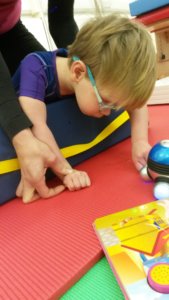
Help your child onto a roll or a wedge with their hands on the ground and their shoulders over their hands. Use cushions or your leg if you don’t have a roll or wedge at home. Try to encourage your child to lift their head, which will in turn make them push through their hands. Books or TV are great motivators for this activity.
To progress this, encourage play in this position so they lift one hand. This could be helping to turn a page of a book or playing with a ball.
If they manage this then move them further forward over the roll or wedge (or cushions) so that more of their weight comes over their hands. Try lifting a hand again for play.
Start just trying to maintain a hands and knees position with your child. It may be easier to start with the child sitting back on their heels and just balancing through their arms.
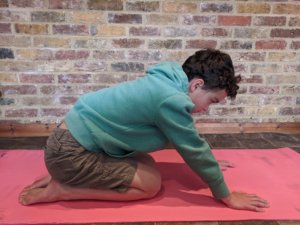
As they get stronger, move their bodies forward until their shoulders are over their hands and their hips are over their knees. While they learn to hold this position, watching activities are the best, like looking at a tablet or reading a book so they don’t have to move their arms.
Once they are stable on their hands and knees, practice lifting one hand to play. They could play on a tablet with one hand, do a puzzle or play with a car or a ball.
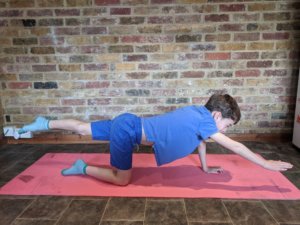
On their hands and knees, encourage your child to reach one arm straight out in front of them in the air. You can challenge them to balance a beanbag or soft toy on the back of their hand to keep it up. Try and hold for 20 seconds.
Now see if they can lift one leg straight out behind them. Try and hold this for 20 seconds.
Can they do an opposite arm and leg at the same time and hold it for 20 seconds? This will challenge their shoulder, elbow and hands stability muscles.
Try the other side.
Now try and lift one leg straight out behind them, holding for one minute this time.
Repeat the above activities again but holding for one minute.
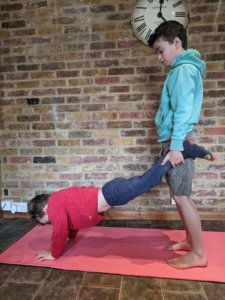 Wheelbarrow is a very difficult task so make sure you start at the stage in the list below that your child can manage without dropping their tummy or arching their backs. Each progression will be hard so take your time to get down the list: it is better to do one exercise well rather than do them all badly.
Wheelbarrow is a very difficult task so make sure you start at the stage in the list below that your child can manage without dropping their tummy or arching their backs. Each progression will be hard so take your time to get down the list: it is better to do one exercise well rather than do them all badly.
Hold your child by their hips with their legs straddling you and their hands on the floor. Move around the floor picking up objects for as far as you can go.
Move your hands down to your child’s knees and walk around the room – picking up objects or playing a matching game or skittles.
If you can, hold your child by their ankles. Make sure they keep their bottom in the air and don’t hang their tummy down. Again find a game to make this more entertaining.
As your child gets stronger you could try to get from one end of the house to the other – even trying going up any steps or the stairs.
You could also make an obstacle course to go around or over.
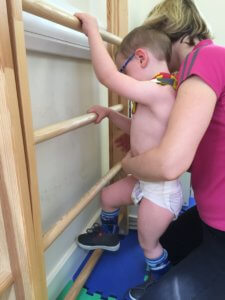
Any climbing using hands will be good for hand and shoulder strength and stability. This includes climbing on furniture or up the stairs. The more weight which goes through the arms, the better.
The most challenging activity is hanging on a bar or going along monkey bars. Try getting your child to hang off a door (supervised of course) or your hands if you don’t have access to a bar to hang from.
This video takes you through the process of doing a headstand. Watch the whole thing through before you try. Make sure your child is stable at each step to avoid injury later on.
This video is great for teaching a smaller child the beginning steps of a handstand. The final step is up against a wall.
2. This video is appropriate for teaching handstand to older and stronger children who love a physical challenge: Workout Series: How to Master the Handstand.
If your child is very physical this will be a good challenge and may also help to calm and regulate them. Remember to stay with your child throughout these exercises for safety.
Wrist, hand and finger strengthening exercises and activities
See this ‘Our Home’ video on hand strengthening with playdough – kneading, pulling apart, squashing or wringing the playdough can all be great hand strengthening exercises.
For finger strengthening, try hiding objects in the dough and your child has to manipulate it to get the toy.
Squeezing bottles is a lovely way to strengthen fingers. Fill an empty toothpaste tube, ketchup bottle or other container with a spout with liquid or yoghurt and have fun squeezing the liquid out.
Put soft salt/playdough in a plastic bag and make a small hole. Squeezing it out can make a lovely snake of dough.
Squeeze stress balls. Encourage your child to squeeze this or just poke into it with their fingers. See our ‘Our Home’ video for an easy way to make a stress ball at home.
-
Cut a piece of hard card into a head shape, and draw on a face. Your child can clip on clothes pegs to make hair.
-
Wrap string around some chair legs and peg pegs to the string for your child to remove.
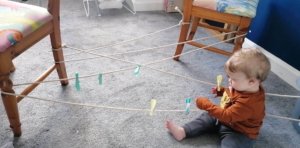
-
Do a scavenger hunt. Clip pegs around the house on bits of material, paper, drawer handles etc. The child can then go around the house or the room (depending on their mobility) to find the pegs and take them off. See this ‘Our Home’ video which shows how to use a tablet to set up a scavenger hunt.
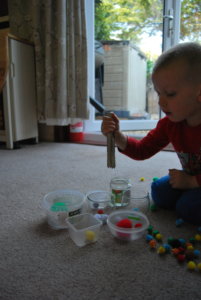
Using home implements can be brilliant for strengthening hands. Give your child some kitchen or BBQ tongs and see if they can pick up items like socks, soft toys or small cushions.
You could set this up as a scavenger hunt too. Take photos of objects your child needs to pick up with their tongs from around the home/room and bring back to you.
For finger strengthening, use tweezers instead of tongs and pick up small items such as dry pasta. See how quickly your child can pick up ten pasta pieces and put them in a bowl the other side of the room.
Collect any spare nuts and bolts (and washers) you have around the house.
Cut out a shape in card (dinosaur, snake, tree – whatever your child would like) and cut small holes or slits into it.
Your child can amuse themselves threading the bolts through the holes and screwing the nuts and washers onto them to make some cool 3D art.
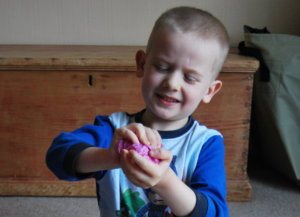
Use a large piece of newspaper and ask your child to scrunch it into the smallest ball they can with two hands.
Now ask them to do it with one hand. The manipulation needed for this will strengthen all the small intricate muscles of the hands.
Using scissors is a great way to strengthen hands. Because scissors can be dangerous thought it’s important to make sure our child is supervised while using them.
Start by cutting dough as this teaches the right way to cut. Make a snake out of dough and ask your child to cut it into pieces.
Move on to cutting straight lines on card or paper. As their skills develop you can be inventive with your cutting and draw interesting shapes for them to cut.
See this ‘Our Home’ video for instructions on how to make a Minecraft man chain with straight line cutting.





